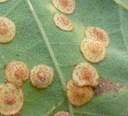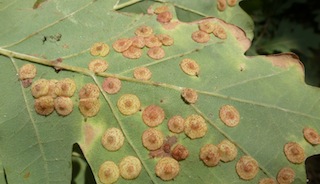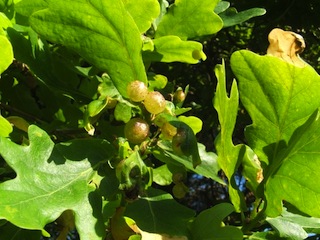 Spangle Galls, which are created by a parasitic wasp, are one of the many kinds of galls found on oak trees. These were spotted at Croft Noweth on Goonhilly.
Spangle Galls, which are created by a parasitic wasp, are one of the many kinds of galls found on oak trees. These were spotted at Croft Noweth on Goonhilly.
Photo: Steve Townsend
Scientific name: Neuroterus quercusbaccarum (this is the name of the parasitic gall-wasp that induces the galls)
What to look for:
- Appearance: The Spangle Galls are tiny (≤5 mm) flat discs, yellowish in colour with tufts of reddish hairs and a raised spot in the centre. The same parasitic wasp forms Currant Galls in the spring (see main text below). These are up to 6 mm in diameter, round and green with red markings.
- Where: On native oak tree species.
- When: The Spangle Galls appear on leaf undersides in autumn, the Currant Galls hang from fresh leaves and catkins in the spring.
- Similar to: There are several kinds of spangle-like galls.
 We are used to thinking of biodiversity as applying to whole landscapes and wider habitats, but it can just as equally apply to a metre-by-metre plot, or a single tree. One oak tree, for example, hosts far more creatures and plants than a large field in which a single crop is growing. Our native oak species have been with us since the last ice age, and since then have developed symbiotic and parasitic relationships with hundreds of other species. It is therefore not surprising that, of the 90 or so gall wasp species found in Britain, 42 are parasitic on oaks.
We are used to thinking of biodiversity as applying to whole landscapes and wider habitats, but it can just as equally apply to a metre-by-metre plot, or a single tree. One oak tree, for example, hosts far more creatures and plants than a large field in which a single crop is growing. Our native oak species have been with us since the last ice age, and since then have developed symbiotic and parasitic relationships with hundreds of other species. It is therefore not surprising that, of the 90 or so gall wasp species found in Britain, 42 are parasitic on oaks.
One common oak gall is the Spangle Gall, created by the parasitic gall wasp Neuroterus quercusbaccarum on our two native oak species, Pedunculate Oak and Sessile Oak. Its tiny flat discs, each no more than 5 mm in diameter, can be found liberally adorning the underside of oak leaves in the autumn. Each yellowish disc has a central ‘pimple’ and a few tufts of red hairs: a hand lens may come in handy to see these features in detail. The discs become redder as they age, and each is attached to the oak leaf by a short stalk.
 In the winter the galls fall off the leaves and become mixed in with the leaf litter. They do this before the leaves fall to the ground: any that do not detach before the leaves fall will die. The grubs develop inside the galls and emerge as adults in the spring. This is the asexual, all-female generation. The wasps lay their eggs in the newly developing oak buds: this will become the sexual generation, the galls of which develop on catkins or fresh leaves. These are called Currant Galls, and it’s easy to see why from their round shape, soft texture and the way they hang on stalks: turning redder as they age, they look like redcurrants. Adult wasps emerge in the summer to mate and then lay eggs in oak leaves: these will form the next set of Common Spangle Galls in the autumn. Oak trees are not generally adversely affected by the presence of Spangle Galls.
In the winter the galls fall off the leaves and become mixed in with the leaf litter. They do this before the leaves fall to the ground: any that do not detach before the leaves fall will die. The grubs develop inside the galls and emerge as adults in the spring. This is the asexual, all-female generation. The wasps lay their eggs in the newly developing oak buds: this will become the sexual generation, the galls of which develop on catkins or fresh leaves. These are called Currant Galls, and it’s easy to see why from their round shape, soft texture and the way they hang on stalks: turning redder as they age, they look like redcurrants. Adult wasps emerge in the summer to mate and then lay eggs in oak leaves: these will form the next set of Common Spangle Galls in the autumn. Oak trees are not generally adversely affected by the presence of Spangle Galls.
Did you know…?
…Galls are chemically induced to form by the developing grubs
…A single oak leaf can be host to up to 100 Spangle Galls
More information and references:
Chinery, M., 2011. Britain’s Plant Galls. A Photographic Guide. WildGuides Ltd., Hampshire.
Redfern, M. and Shirley, P., 2011. British Plant Galls (second edition). Field Studies Council, Shropshire.
Published: October 2014
Author: Amanda Scott
Photos: Spangle Galls: Steve Townsend; Currant Galls: Lairich Rig [CC-BY-SA-2.0], via Wikimedia Commons

